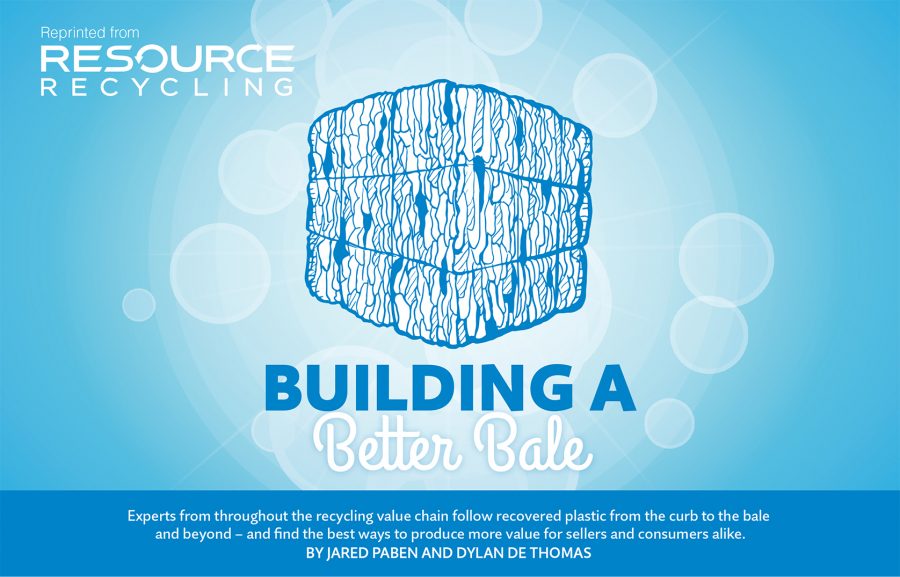This story originally appeared in the March 2016 issue of Resource Recycling.
Subscribe today for access to all print content.

Addressing over 200 attendees at last month’s Association of Plastic Recyclers Technical Forum, John Standish emphasized the importance of viewing bales of recovered plastics as feedstock for a manufacturing operation, not simply discards to be diverted from landfill.
“In any modern, high-volume, automated process, the quality of the raw materials is very important to the success of the process,” said Standish, the technical director of the Association of Plastic Recyclers (APR). “And in plastics recycling, the raw materials are bales of plastic bottles and other plastic articles.”
As Standish noted, the quality of those raw materials impacts every single aspect of the value chain, because it “affects product yield, waste, labor requirements, material quality and more.”
The economics of plastics recycling are important and increasingly complex. “Just looking at PET, the cost of a new PET recycling plant is on the order of $30 million or more, and it can handle 75 million pounds of material per year,” Standish said.
Standish and APR gathered industry experts from across the material stream, including equipment experts, a program design professional and a leading PET reclaimer, to share their insights at the Technical Forum, held at Plastics Recycling 2016 in New Orleans in early February.
The stakes are high because it affects so many different aspects of the plastics recycling industry. In down markets, such as the one the industry currently finds itself in, efficiencies and best practices must be found. And those best practices start with the rollcarts residents set out at the curb.
Improving bale quality at the curb
Reducing contamination starts before material ever lands on a MRFs tipping floor – it starts at the curb, said Cody Marshall, technical assistance lead at The Recycling Partnership.
The Falls Church, Va.-headquartered nonprofit group relies on financial support from manufacturers, consumer goods companies and recycling industry groups to invest in residential collections infrastructure. In 2015, its matching grants enabled the purchase of 165,000 carts for 1.2 million people. The group also provides technical assistance, conducts public outreach and builds local community champions for improvements to curbside recycling.

Cody Marshall, technical assistance lead at The Recycling Partnership, talks about strategies for reducing contamination before material arrives at MRFs.
“We want to make sure that the equipment and the MRF operator don’t have to work so hard,” he said.
Around the country, about 15 to 18 percent of what trucks tip at MRFs is contamination, Marshall said, and the causes are many: confusing, overly detailed acceptable/unacceptable lists; MRF-municipality contracts that fail to hold governments accountable for contaminated loads; and a confusing patchwork of container types and collection systems, hauling companies and MRF operators.
“Education isn’t going to solve and clean up the stream, and operations certainly isn’t going to do it on its own either,” he said. “Where those two meet is where you find success and get good quality material.”
He advocates for using simple communications, perhaps choosing the top five contaminants for a list of prohibited materials, noting that “you only have about seven seconds to really capture your residents’ attentions on what to recycle and what not to recycle.”
Local governments should also be communicating regularly with MRFs about contamination and acceptable materials, rather than every few years, when a contract is expiring. And, unlike in many other businesses, refusing to serve a recycling customer may actually be the best move.
“You need to start making sure your operations have a protocol to reject carts at the curb,” he said. “Communicate at the curb, understand that collecting everything isn’t actually the best service, because if your community isn’t getting dinged for contamination, they’re going to start getting dinged for contamination.”
Springfield, Mass., for example, was getting charged by a MRF for its 24 percent contamination rate. The City began measuring the problem, tagging bins and leaving notes behind and, within a year, the rate was down to 10 percent. The number of tagged carts per day dropped from 68 to 10.
“They found that 10 percent of the population was causing about 90 percent of the problem,” Marshall said.
Design process for success
MRF operators also can take steps to ensure their systems are ready to remove contaminants before they land in the baler.
A proper sortation line design starts at the materials source, including whether the stream originates at single-family houses, multi-family homes or stores and factories, said Matthias Erdmannsdoerfer, president of Nashville, Tenn.-based National Recovery Technologies (NRT), a Bulk Handling Systems company. The source influences the design and performance of MRFs.
And the key isn’t strictly about having technologically advanced or perfectly suited equipment, he said. It’s how pieces work together.

Matthias Erdmannsdoerfer, president of National Recovery Technologies, answers a question during the Association of Plastics Recyclers Technical Forum while Ryan Pawlinski (left), supply chain manager at Phoenix Technologies International, and Cody Marshall, technical assistance lead at The Recycling Partnership, look on.
“When talking about the MRFs’ impact on PET bales, it is really not about the individual components in the MRF. It’s really not about how well does your optical work, what screens are you using,” he said. “But it’s really ‘how do you put these together’ and how do you prepare for each step upstream to make sure you have the desired outcome downstream in your plant.”
For example, while he stressed the importance and ubiquity of optical sorters in modern MRF, the technology uses air jets to separate material. That means there’s a chance of “collateral ejections,” or air jets blowing out material, including contamination, adjacent to the desired plastic containers.
“Presentation of the material – singulation of the material – everything you have done before to get to that step is extremely important to generate these clean bales,” he said.
Sorting out contamination
That presentation of the material is important to what is often called the single-most important tool to improve bale quality – the optical sortation device.
Felix Hottenstein, sales director for MSS Optical Sorters, a division of the CP Group, discussed recent innovations in the space of optical sorters. [Ed: It should be noted that all three of the equipment providers that presented produce optical sortation devices, as do numerous other companies from around the world.]
Hottenstein noted that when using optical sorters for plastic containers, a company is looking to maximize final product quality – the bale of plastics produced at a facility. These benefits include being able to minimize loss of good, or desired material; managing new substrate and label or sleeve materials in and covering containers; and for new applications, such as smaller packaging or packaging made from multi-layer flexible film packaging.
Some of the technology employed by many new near-infrared (NIR) sortation devices include using a greater amount of the NIR wavelengths available to identify a larger range of plastic materials (See Figure 1).
The newer models of these devices are also able to handle properly presented materials at greater speeds and with greater accuracy than in year’s past. Too, the pixel resolution of high-definition models is also much higher.
New NIR sortation devices, such as the ones produced by MSS, are able to identify different substrate containers below full shrink-sleeve labels, which the human eye cannot do, Hottenstein said.
While the investment in new technology has value to a MRF or PRF or reclaimer, he also noted that there are practices that facility operators can employ to improve bale quality without a large capital investment, notably to “use the equipment as designed.” Properly maintaining the equipment is also important to lengthen its lifespan, he noted, as well as maximizing its effectiveness.
Fine-tuning cleanup at a MRF
Mark Neitzey, director of sales for Stamford, Conn.-based Van Dyk Recycling Solutions, explored the way MRF lines can be fine-tuned to keep unwanted materials out of container streams and produce better bales.

Mark Neitzey, director of sales for Van Dyk Recycling Solutions, speaks during the forum as Felix Hottenstein, sales director for MSS Optical Sorters, listens.
As best practices, MRF operators should conduct community outreach efforts, alter the list of accepted materials and ensure the system is running only at its rated capacity. They should also conduct proactive maintenance on equipment, including routine star/disk replacements on screens and regularly train staff.
Lastly, certain “clean-up devices” can be added to better prepare material for the MRF container line. One such device is a fines screen with a suction system, which agitates the materials mix and removes fines and light material with air.
Another is a ballistic separator, a machine that, though rare in North America, has been shown in Europe to effectively separate two-dimensional fibers and films from three-dimensional containers while simultaneously removing fines. Neitzey said another way to accomplish 2-D/3-D separation is with a paper magnet or air drum separator, devices that use a combination of air and a rotating shaft of paddles to remove film off the line, leaving a cleaned fiber stream in its wake.
Neitzey acknowledged adding clean-up devices isn’t a cinch. MRFs can find it difficult to squeeze them into existing building footprints, and they come with capital costs. Additionally, the MRF must schedule downtime needed to install the equipment.
Lastly, operators must still figure out how to handle the by-products created by the equipment, he said.
Recovery at the reclaimer
Bowling Green, Ohio-based PET reclaimer Phoenix Technologies International sees less usable PET and more contamination in bales. But while MRFs may immediately think of plastic bags and garden hoses as problematic sources of contamination, Phoenix Technologies is also challenged by additives, adhesives and inks in and on PET containers.
Ryan Pawlinski, supply-chain manager at Phoenix, which has sourced more than 1 billion pounds of material from around the world, discussed the challenges a reclaimer faces with today’s plastics stream.
Major brands are driving demand for recycled PET, asking for higher post-consumer resin content but at prices comparable to virgin resin. Yet higher recycled content percentages can present challenges. Because the recycled resin can have a yellowing effect in clear packaging – a particular problem for thick-walled packages such as jars and cosmetic and pharmaceutical containers – it becomes more important to have a cleaner post-consumer stream.
Even clean water bottles can present challenges as they become more common in bales. That’s because they have lower internal viscosities, requiring more thermal processing to strengthen the plastic. But that process can harm the plastic’s clarity and brightness.
In addition, a multitude of packaging types exist today, and some include additives to boost shelf life or UV stability, as well as shrink-wrap labels and bright colors to boost shelf appeal. For example, full wrap labels can require a reclaimer to use a label scraper but that can remove some of the bottle’s neck, resulting in a loss of usage PET.
Add to that lightweighting, thermoforms made of different resins and geographic differences in packaging types and MRF technologies and the result is lower bale yields and increased costs.
“There are things in these bales that we do not really want to see or focus on,” Pawlinski said.
Those contaminants increase the employees, equipment and energy needed to handle the same weight of material.
He used the example of a theoretical 1,000-pound bale costing 10 cents per pound, including freight. If Phoenix is only able to reclaim 64 percent of the bale, or 640 pounds, and the remaining weight is unusable, the effective price paid for usage PET increases to 15.7 cents per pound, Pawlinski said.
One recommendation offered was for reclaimers to work closely with brand owners to help them understand the impacts their packaging has on recycling. He also suggested reclaimers communicate more regularly with MRFs to help them remove contaminants, which can often be done without adding equipment to the MRF.
He emphasized reclaimers should invest in the newest technologies and keep employees up-to-date. Employee education can be simple. Phoenix created a “go/no go” line to show employees what’s acceptable and what’s not. It was simply a piece of plywood with examples of bottles on it, but the approach worked to increase quality significantly.

